Maohao Shen
Satori-SWE: Evolutionary Test-Time Scaling for Sample-Efficient Software Engineering
May 29, 2025Abstract:Language models (LMs) perform well on standardized coding benchmarks but struggle with real-world software engineering tasks such as resolving GitHub issues in SWE-Bench, especially when model parameters are less than 100B. While smaller models are preferable in practice due to their lower computational cost, improving their performance remains challenging. Existing approaches primarily rely on supervised fine-tuning (SFT) with high-quality data, which is expensive to curate at scale. An alternative is test-time scaling: generating multiple outputs, scoring them using a verifier, and selecting the best one. Although effective, this strategy often requires excessive sampling and costly scoring, limiting its practical application. We propose Evolutionary Test-Time Scaling (EvoScale), a sample-efficient method that treats generation as an evolutionary process. By iteratively refining outputs via selection and mutation, EvoScale shifts the output distribution toward higher-scoring regions, reducing the number of samples needed to find correct solutions. To reduce the overhead from repeatedly sampling and selection, we train the model to self-evolve using reinforcement learning (RL). Rather than relying on external verifiers at inference time, the model learns to self-improve the scores of its own generations across iterations. Evaluated on SWE-Bench-Verified, EvoScale enables our 32B model, Satori-SWE-32B, to match or exceed the performance of models with over 100B parameters while using a few samples. Code, data, and models will be fully open-sourced.
RL Tango: Reinforcing Generator and Verifier Together for Language Reasoning
May 21, 2025Abstract:Reinforcement learning (RL) has recently emerged as a compelling approach for enhancing the reasoning capabilities of large language models (LLMs), where an LLM generator serves as a policy guided by a verifier (reward model). However, current RL post-training methods for LLMs typically use verifiers that are fixed (rule-based or frozen pretrained) or trained discriminatively via supervised fine-tuning (SFT). Such designs are susceptible to reward hacking and generalize poorly beyond their training distributions. To overcome these limitations, we propose Tango, a novel framework that uses RL to concurrently train both an LLM generator and a verifier in an interleaved manner. A central innovation of Tango is its generative, process-level LLM verifier, which is trained via RL and co-evolves with the generator. Importantly, the verifier is trained solely based on outcome-level verification correctness rewards without requiring explicit process-level annotations. This generative RL-trained verifier exhibits improved robustness and superior generalization compared to deterministic or SFT-trained verifiers, fostering effective mutual reinforcement with the generator. Extensive experiments demonstrate that both components of Tango achieve state-of-the-art results among 7B/8B-scale models: the generator attains best-in-class performance across five competition-level math benchmarks and four challenging out-of-domain reasoning tasks, while the verifier leads on the ProcessBench dataset. Remarkably, both components exhibit particularly substantial improvements on the most difficult mathematical reasoning problems. Code is at: https://github.com/kaiwenzha/rl-tango.
Satori: Reinforcement Learning with Chain-of-Action-Thought Enhances LLM Reasoning via Autoregressive Search
Feb 04, 2025



Abstract:Large language models (LLMs) have demonstrated remarkable reasoning capabilities across diverse domains. Recent studies have shown that increasing test-time computation enhances LLMs' reasoning capabilities. This typically involves extensive sampling at inference time guided by an external LLM verifier, resulting in a two-player system. Despite external guidance, the effectiveness of this system demonstrates the potential of a single LLM to tackle complex tasks. Thus, we pose a new research problem: Can we internalize the searching capabilities to fundamentally enhance the reasoning abilities of a single LLM? This work explores an orthogonal direction focusing on post-training LLMs for autoregressive searching (i.e., an extended reasoning process with self-reflection and self-exploration of new strategies). To achieve this, we propose the Chain-of-Action-Thought (COAT) reasoning and a two-stage training paradigm: 1) a small-scale format tuning stage to internalize the COAT reasoning format and 2) a large-scale self-improvement stage leveraging reinforcement learning. Our approach results in Satori, a 7B LLM trained on open-source models and data. Extensive empirical evaluations demonstrate that Satori achieves state-of-the-art performance on mathematical reasoning benchmarks while exhibits strong generalization to out-of-domain tasks. Code, data, and models will be fully open-sourced.
VCA: Video Curious Agent for Long Video Understanding
Dec 12, 2024
Abstract:Long video understanding poses unique challenges due to their temporal complexity and low information density. Recent works address this task by sampling numerous frames or incorporating auxiliary tools using LLMs, both of which result in high computational costs. In this work, we introduce a curiosity-driven video agent with self-exploration capability, dubbed as VCA. Built upon VLMs, VCA autonomously navigates video segments and efficiently builds a comprehensive understanding of complex video sequences. Instead of directly sampling frames, VCA employs a tree-search structure to explore video segments and collect frames. Rather than relying on external feedback or reward, VCA leverages VLM's self-generated intrinsic reward to guide its exploration, enabling it to capture the most crucial information for reasoning. Experimental results on multiple long video benchmarks demonstrate our approach's superior effectiveness and efficiency.
Get Large Language Models Ready to Speak: A Late-fusion Approach for Speech Generation
Oct 27, 2024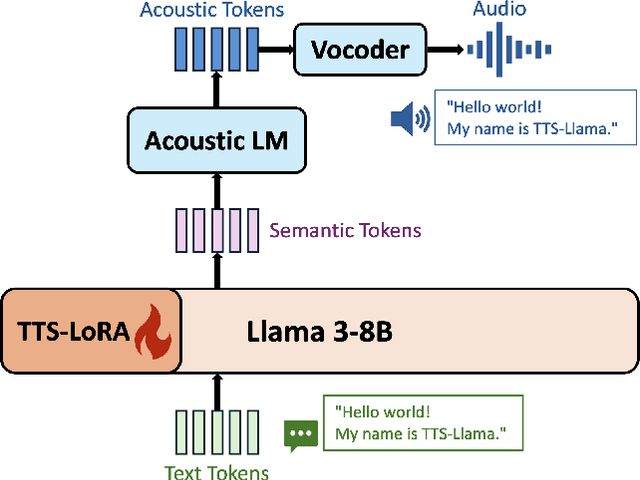
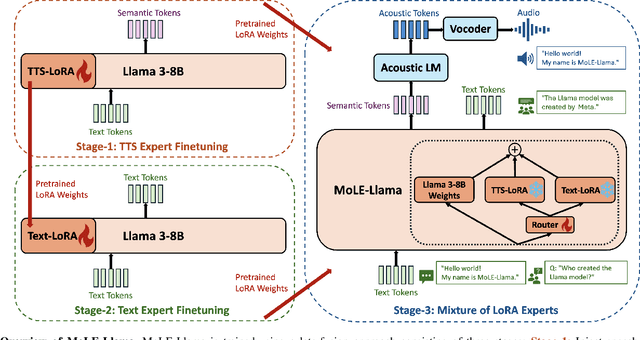
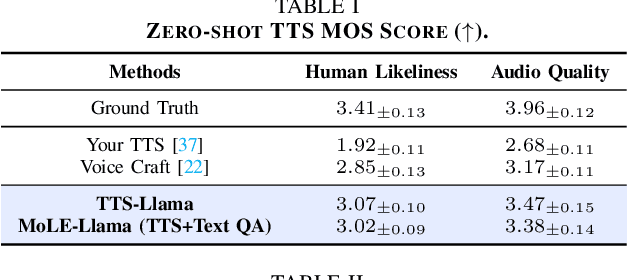
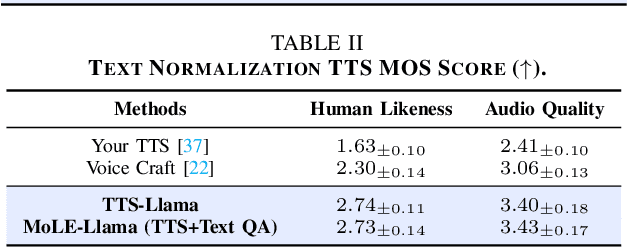
Abstract:Large language models (LLMs) have revolutionized natural language processing (NLP) with impressive performance across various text-based tasks. However, the extension of text-dominant LLMs to with speech generation tasks remains under-explored. In this work, we introduce a text-to-speech (TTS) system powered by a fine-tuned Llama model, named TTS-Llama, that achieves state-of-the-art speech synthesis performance. Building on TTS-Llama, we further propose MoLE-Llama, a text-and-speech multimodal LLM developed through purely late-fusion parameter-efficient fine-tuning (PEFT) and a mixture-of-expert architecture. Extensive empirical results demonstrate MoLE-Llama's competitive performance on both text-only question-answering (QA) and TTS tasks, mitigating catastrophic forgetting issue in either modality. Finally, we further explore MoLE-Llama in text-in-speech-out QA tasks, demonstrating its great potential as a multimodal dialog system capable of speech generation.
Improved Evidential Deep Learning via a Mixture of Dirichlet Distributions
Feb 09, 2024
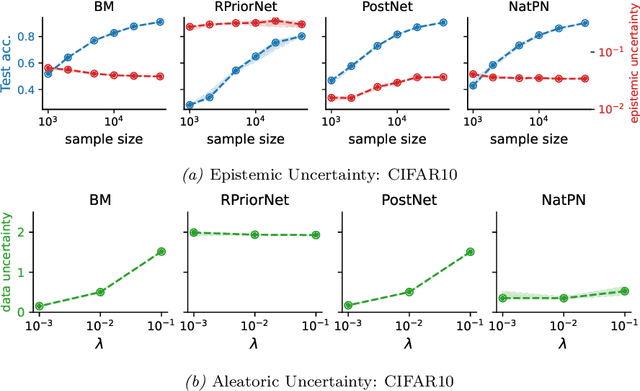
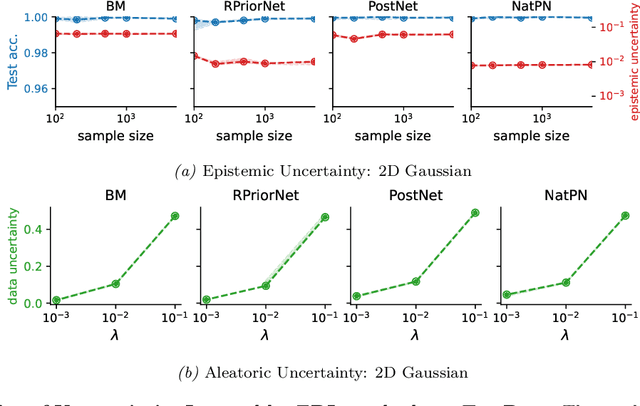
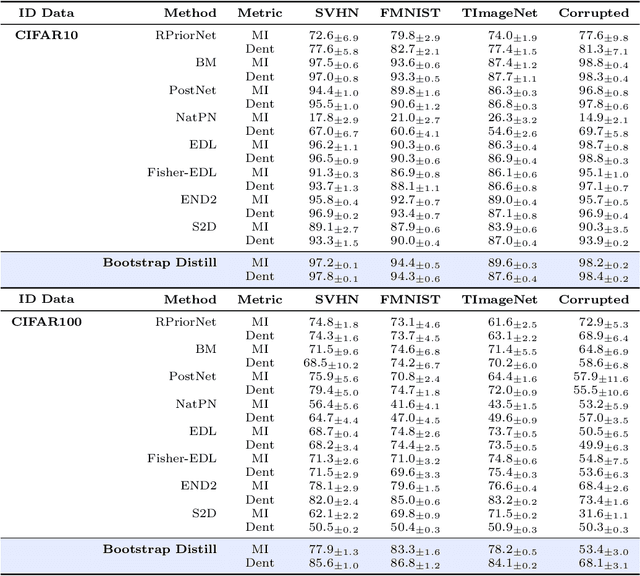
Abstract:This paper explores a modern predictive uncertainty estimation approach, called evidential deep learning (EDL), in which a single neural network model is trained to learn a meta distribution over the predictive distribution by minimizing a specific objective function. Despite their strong empirical performance, recent studies by Bengs et al. identify a fundamental pitfall of the existing methods: the learned epistemic uncertainty may not vanish even in the infinite-sample limit. We corroborate the observation by providing a unifying view of a class of widely used objectives from the literature. Our analysis reveals that the EDL methods essentially train a meta distribution by minimizing a certain divergence measure between the distribution and a sample-size-independent target distribution, resulting in spurious epistemic uncertainty. Grounded in theoretical principles, we propose learning a consistent target distribution by modeling it with a mixture of Dirichlet distributions and learning via variational inference. Afterward, a final meta distribution model distills the learned uncertainty from the target model. Experimental results across various uncertainty-based downstream tasks demonstrate the superiority of our proposed method, and illustrate the practical implications arising from the consistency and inconsistency of learned epistemic uncertainty.
Reliable Gradient-free and Likelihood-free Prompt Tuning
Apr 30, 2023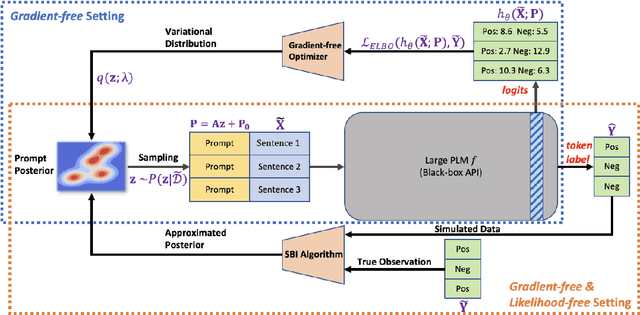



Abstract:Due to privacy or commercial constraints, large pre-trained language models (PLMs) are often offered as black-box APIs. Fine-tuning such models to downstream tasks is challenging because one can neither access the model's internal representations nor propagate gradients through it. This paper addresses these challenges by developing techniques for adapting PLMs with only API access. Building on recent work on soft prompt tuning, we develop methods to tune the soft prompts without requiring gradient computation. Further, we develop extensions that in addition to not requiring gradients also do not need to access any internal representation of the PLM beyond the input embeddings. Moreover, instead of learning a single prompt, our methods learn a distribution over prompts allowing us to quantify predictive uncertainty. Ours is the first work to consider uncertainty in prompts when only having API access to the PLM. Finally, through extensive experiments, we carefully vet the proposed methods and find them competitive with (and sometimes even improving on) gradient-based approaches with full access to the PLM.
Group Fairness with Uncertainty in Sensitive Attributes
Feb 16, 2023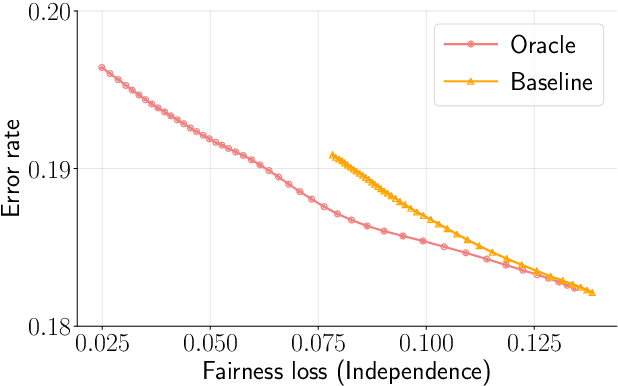



Abstract:We consider learning a fair predictive model when sensitive attributes are uncertain, say, due to a limited amount of labeled data, collection bias, or privacy mechanism. We formulate the problem, for the independence notion of fairness, using the information bottleneck principle, and propose a robust optimization with respect to an uncertainty set of the sensitive attributes. As an illustrative case, we consider the joint Gaussian model and reduce the task to a quadratically constrained quadratic problem (QCQP). To ensure a strict fairness guarantee, we propose a robust QCQP and completely characterize its solution with an intuitive geometric understanding. When uncertainty arises due to limited labeled sensitive attributes, our analysis reveals the contribution of each new sample towards the optimal performance achieved with unlimited access to labeled sensitive attributes. This allows us to identify non-trivial regimes where uncertainty incurs no performance loss of the proposed algorithm while continuing to guarantee strict fairness. We also propose a bootstrap-based generic algorithm that is applicable beyond the Gaussian case. We demonstrate the value of our analysis and method on synthetic data as well as real-world classification and regression tasks.
Post-hoc Uncertainty Learning using a Dirichlet Meta-Model
Dec 14, 2022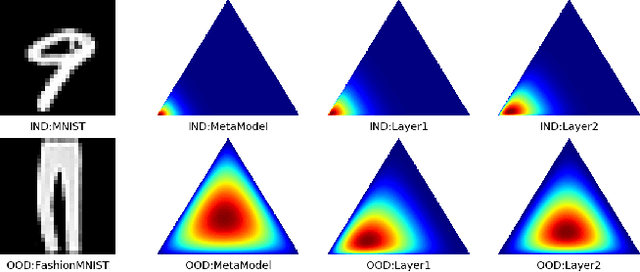
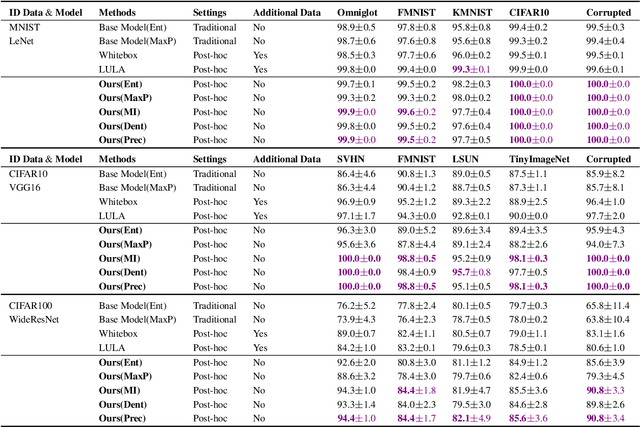
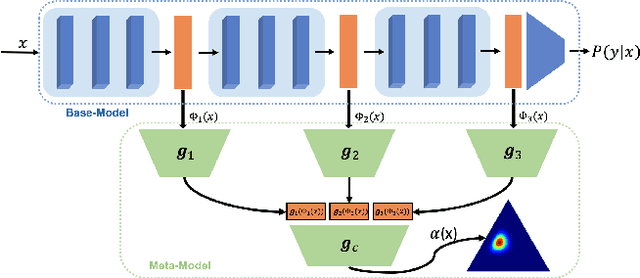

Abstract:It is known that neural networks have the problem of being over-confident when directly using the output label distribution to generate uncertainty measures. Existing methods mainly resolve this issue by retraining the entire model to impose the uncertainty quantification capability so that the learned model can achieve desired performance in accuracy and uncertainty prediction simultaneously. However, training the model from scratch is computationally expensive and may not be feasible in many situations. In this work, we consider a more practical post-hoc uncertainty learning setting, where a well-trained base model is given, and we focus on the uncertainty quantification task at the second stage of training. We propose a novel Bayesian meta-model to augment pre-trained models with better uncertainty quantification abilities, which is effective and computationally efficient. Our proposed method requires no additional training data and is flexible enough to quantify different uncertainties and easily adapt to different application settings, including out-of-domain data detection, misclassification detection, and trustworthy transfer learning. We demonstrate our proposed meta-model approach's flexibility and superior empirical performance on these applications over multiple representative image classification benchmarks.
Batch Active Learning from the Perspective of Sparse Approximation
Nov 05, 2022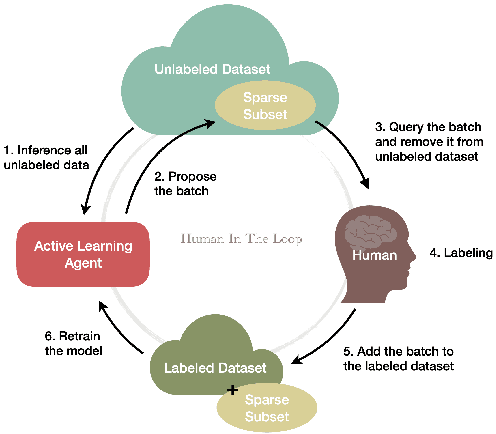

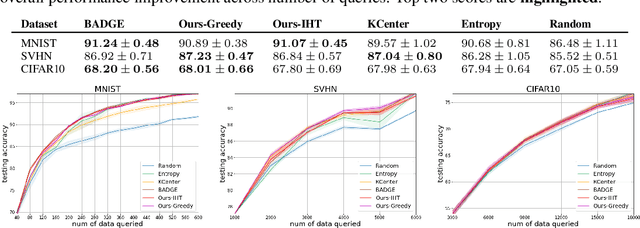

Abstract:Active learning enables efficient model training by leveraging interactions between machine learning agents and human annotators. We study and propose a novel framework that formulates batch active learning from the sparse approximation's perspective. Our active learning method aims to find an informative subset from the unlabeled data pool such that the corresponding training loss function approximates its full data pool counterpart. We realize the framework as sparsity-constrained discontinuous optimization problems, which explicitly balance uncertainty and representation for large-scale applications and could be solved by greedy or proximal iterative hard thresholding algorithms. The proposed method can adapt to various settings, including both Bayesian and non-Bayesian neural networks. Numerical experiments show that our work achieves competitive performance across different settings with lower computational complexity.
 Add to Chrome
Add to Chrome Add to Firefox
Add to Firefox Add to Edge
Add to Edge